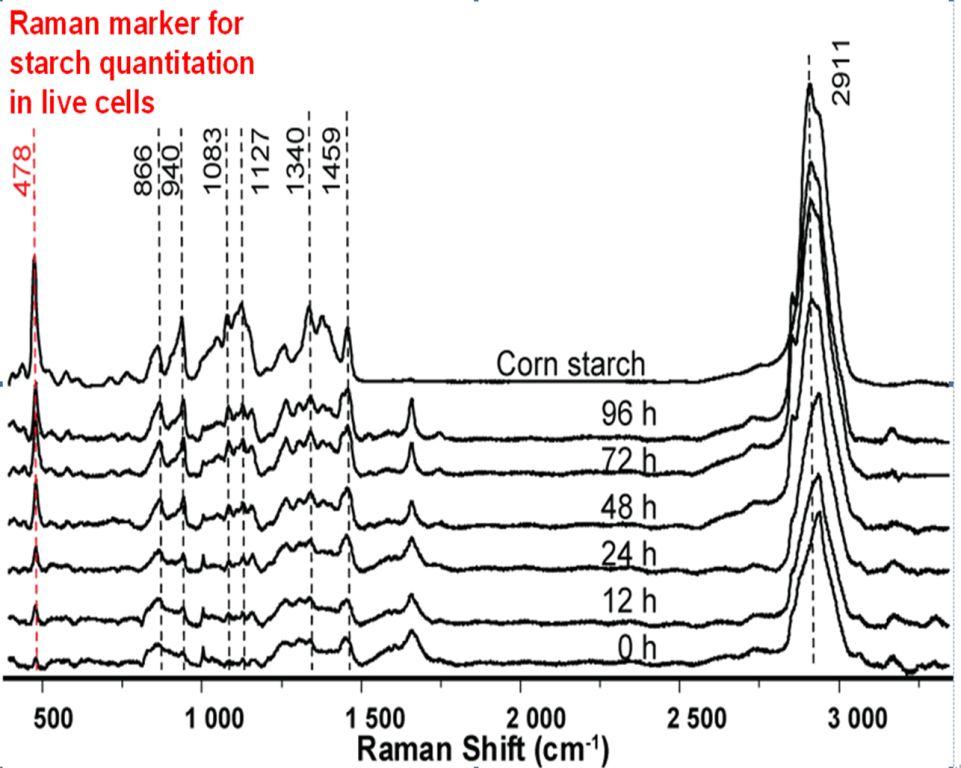
QIBEBT Develops Novel Approach for Quantitation of Starch in Live, Unicellular Microalgae
Jun 11, 2014 Email"> PrintText Size

Microalgae are able to convert solar energy and carbon dioxide to energy storage compounds such as starch and lipids to produce food and biofuels. Therefore screening and engineering strains for higher starch productivity have been of great interest. Multiple methods have been developed to measure the starch content in tissues and cellular biomass, however they usually require multiple steps that include extraction of starch from cells, hydrolyzation with either acids or enzymes to glucose, which is subsequently quantified colorimetrically via enzymatic reactions. These methods are invasive, labor intensive, limited in throughput and demanding in terms of reagents and consumables. On the other hand, as these methods require the cumulative biomass from a large number of cells and thus are culture-dependent, wild-type or mutant cells that are not yet cultured or difficult to cultivate have been beyond the reach of these approaches.
A research team led by Prof. XU Jian from Single-Cell Center, Qingdao Institute of BioEnergy and Bioprocess Technology, Chinese Academy of Sciences (QIBEBT) has now established a novel approach for quantitation of starch in live, unicellular microalgae at single-cell resolution. The work is published in Biotechnology Journal.
A nearly linear correlation (R2=0.99) between the Raman signal intensity at 478 cm−1 and the starch content of algal biomass was validated in both Chlamydomonas reinhardtii and Chlorella pyrenoidosa (Figure 1). Compared to existing methods that measure the starch content in tissues and bulk cellular biomass, this SCRS-based approach is rapid, label-free, noninvasive, culture-independent, low-cost and potentially able to simultaneously track multiple metabolites in individual live cells. As throughput, ease of deployment, cost and multiplexing are all important considerations in design of starch assays, such advantages can be exploited for development of many novel applications such as screening of microbial cell factories and optimization of bioprocesses.
This research was supported by the National Basic Research Program, the High-Tech Development Program, as well as the International Innovation Partnership Program from the Chinese Academy of Sciences.

Figure 1 Dynamics of single-cell Raman spectra for Chlamydomonas reinhardtii strains under nitrogen-depleted conditions; the top Raman spectrum is from the standard sample of corn starch. (Image by Single Cell Center, QIBEBT)
Reference:
Ji YT, He YH, Cui YB, Wang TT, Wang Y, Li YG, Huang W, Xu J. Raman spectroscopy provides a rapid, non-invasive method for quantitation of starch in live, unicellular microalgae. Biotechnology Journal, 2014. DOI: 10.1002/biot.201400165
Contact:
Prof. XU Jian
E-mail: xujian (AT) qibebt.ac.cn
Web: http://english.qibebt.cas.cn
Microalgae are able to convert solar energy and carbon dioxide to energy storage compounds such as starch and lipids to produce food and biofuels. Therefore screening and engineering strains for higher starch productivity have been of great interest. Multiple methods have been developed to measure the starch content in tissues and cellular biomass, however they usually require multiple steps that include extraction of starch from cells, hydrolyzation with either acids or enzymes to glucose, which is subsequently quantified colorimetrically via enzymatic reactions. These methods are invasive, labor intensive, limited in throughput and demanding in terms of reagents and consumables. On the other hand, as these methods require the cumulative biomass from a large number of cells and thus are culture-dependent, wild-type or mutant cells that are not yet cultured or difficult to cultivate have been beyond the reach of these approaches.
A research team led by Prof. XU Jian from Single-Cell Center, Qingdao Institute of BioEnergy and Bioprocess Technology, Chinese Academy of Sciences (QIBEBT) has now established a novel approach for quantitation of starch in live, unicellular microalgae at single-cell resolution. The work is published in Biotechnology Journal.
A nearly linear correlation (R2=0.99) between the Raman signal intensity at 478 cm−1 and the starch content of algal biomass was validated in both Chlamydomonas reinhardtii and Chlorella pyrenoidosa (Figure 1). Compared to existing methods that measure the starch content in tissues and bulk cellular biomass, this SCRS-based approach is rapid, label-free, noninvasive, culture-independent, low-cost and potentially able to simultaneously track multiple metabolites in individual live cells. As throughput, ease of deployment, cost and multiplexing are all important considerations in design of starch assays, such advantages can be exploited for development of many novel applications such as screening of microbial cell factories and optimization of bioprocesses.
This research was supported by the National Basic Research Program, the High-Tech Development Program, as well as the International Innovation Partnership Program from the Chinese Academy of Sciences.
Figure 1 Dynamics of single-cell Raman spectra for Chlamydomonas reinhardtii strains under nitrogen-depleted conditions; the top Raman spectrum is from the standard sample of corn starch. (Image by Single Cell Center, QIBEBT)
Reference: 
Ji YT, He YH, Cui YB, Wang TT, Wang Y, Li YG, Huang W, Xu J. Raman spectroscopy provides a rapid, non-invasive method for quantitation of starch in live, unicellular microalgae. Biotechnology Journal, 2014. DOI: 10.1002/biot.201400165
Contact:
Prof. XU Jian
E-mail: xujian (AT) qibebt.ac.cn
Web: http://english.qibebt.cas.cn
CAS Institutes
There are 124 Institutions directly under the CAS by the end of 2012, with 104 research institutes, five universities & supporting organizations, 12 management organizations that consist of the headquarters and branches, and three other units. Moreover, there are 25 legal entities affiliated and 22 CAS invested holding enterprisesThere are 124 I...>> more
Contact Us

Chinese Academy of Sciences
Add: 52 Sanlihe Rd., Xicheng District, Beijing, China
Postcode: 100864
Tel: 86-10-68597592 (day) 86-10-68597289 (night)
Fax: 86-10-68511095 (day) 86-10-68512458 (night)
E-mail: cas_en@cas.cn

